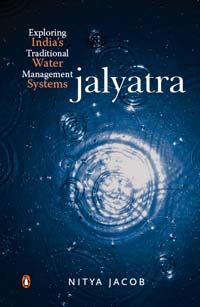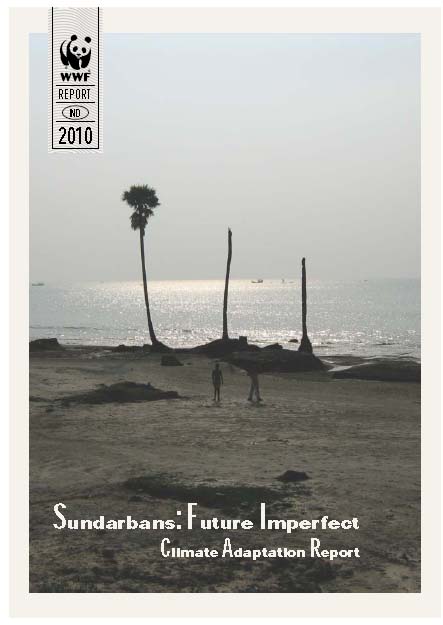Groundwater
Jalyatra: Exploring India's traditional water management systems
Posted on 14 May, 2011 07:34 PM Jalyatra - Exploring India's traditional water management systems, by Nitya Jacob is an ecological travelogue that looks at links between water, society and places It describes in detail what existed, how it fitted into the socio-cultural milieu and was appropriate for the local climate and geography. It then examines reasons for their decline, as indeed most have, in recent decades.
Jalyatra - Exploring India's traditional water management systems, by Nitya Jacob is an ecological travelogue that looks at links between water, society and places It describes in detail what existed, how it fitted into the socio-cultural milieu and was appropriate for the local climate and geography. It then examines reasons for their decline, as indeed most have, in recent decades.
While recording the dismal state of traditional systems, the author stumbles upon small initiatives that have brought about significant transformation across regions. It refers to noisy hidrums and gharaats, the river-run flour mills of Uttaranchal, the technologies whose potential has yet to be fully realised. It looks at water harvesting structures of southern India—the eris and ooranis. However, it admits that the average person is singularly uninterested in protecting the environment.
Jalyatra captures the efforts of NGOs and enlightened individuals striving to revive these systems. It makes the case for a mass movement to revive traditional water management systems, especially village ponds, across the country as the way to ensure water security in India. In Chambal, the author meets Brij Mohan Gujjar, dacoit turned water conservationist, who is doing valuable work on the check dams designed to control the flow of water in the ravines; and in Shillong, Lan Potham shows him the uses of the easily available bamboo to construct the shyngiar which irrigates his areca nut plantation.
Estimation of groundwater resources in Andhra Pradesh - A report by the State Groundwater Department - GoAP (2002)
Posted on 14 May, 2011 05:19 PMThe sustainable development and management of the resource requires precise quantitative assessment based on valid scientific principles. The updated Groundwater Estimation Committee methodology – 1997 has been used and detailed guidelines were formulated through discussions and deliberations in the State Level Groundwater Estimation Committee.
Factors determining informal tanker water markets in Chennai - Blog post by Veena Srinivasan
Posted on 11 May, 2011 05:15 PMIn these, private tanker truck operators transport water extracted from peri-urban wells to urban consumers. This study adopted a systems modeling approach to analyzing the informal tanker market in India. The results indicate that the demand for tanker supply was caused by lack of groundwater availability in private wells as well as unreliable piped supply.
An analysis of West Bengal Ground Water Resources (Management, Control and Regulation) Act 2005
Posted on 11 May, 2011 02:17 PMIntroduction
Bangalore University invites applications from junior research fellow for Isotope Hydrology
Posted on 11 May, 2011 01:47 PMApplications are invited from eligible candidates on plain paper for below mentioned posts to carry out work on Research Project entitled “Modelling of Jakkur & sampigehalli lake water balance and groundwater-surface water interaction using isotope Techniques” sponsored by DST, New Delhi and CWRDM, Kozhikode-673571 for a period of 3 years at Department of Civil Engineering, Bangalore University, Bangalore-560 056.
Junior Research Fellow: One (1)
Fellowship: Rs.16000/-+ 20% HRA (18000/- pm consolidated I & II Year, 20000/-pm in III year)
Hydrology and quality of groundwater in and around Bangalore city - Review and excerpts from the report released in March 2011, by the Department of Mines and Geology (Govt of Karnataka)
Posted on 10 May, 2011 08:34 PMA welcome and important document, it brings up-to-date our understanding of the rapidly changing groundwater situation in Bangalore.
| Month | New borewells added each month | Borewells registered with BWSSB | Monthly % growth |
| Jan-09 | 91018 | ||
| Feb-09 | 924 | 91942 | 1.02 |
| Mar-09 | 705 | 92647 | 0.77 |
| Apr-09 | 965 | 93612 | 1.04 |
| May-09 | 1136 | 94748 | 1.21 |
| Jun-09 | 748 | 95496 | 0.79 |
| Jul-09 | 904 | 96400 | 0.95 |
| Aug-09 | 868 | 97268 | 0.90 |
| Sep-09 | 2062 | 99330 | 2.12 |
| Oct-09 | 838 | 100168 | 0.84 |
| Nov-09 | 875 | 101043 | 0.87 |
| Dec-09 | 2699 | 103742 | 2.67 |
| Jan-10 | 1759 | 105501 | 1.70 |
| Total as on Jan-2010 | 14483 | 105501 | 15.91 |
Growth of bore wells during February 2009 to January 2010 in Bangalore city
Groundwater management in a coastal aquifer in Krishna River Delta – A paper in Current Science
Posted on 10 May, 2011 08:03 AMGroundwater conditions in the multi-aquifer system in the delta, were studied through an integrated approach using hydrochemical, hydrogeological and isotopic techniques. This study was taken up because of the reported seawater intrusion into the groundwater system of this agriculturally rich region.
Sunderbans - A climate adaptation report by World Wildlife Fund India
Posted on 09 May, 2011 09:23 PM Beginning in 2005, WWF-India has conducted dozens of personal interviews to record how climate change impacts people's lives here and now. These perceptions demanded that s
Beginning in 2005, WWF-India has conducted dozens of personal interviews to record how climate change impacts people's lives here and now. These perceptions demanded that s
Addressing the water crisis in Gujarat, India - A report by Columbia Water Center
Posted on 28 Apr, 2011 05:06 PMA large number of farmers and well operators were interviewed in the process. Data was also collected from the power utility that supplies power to this region. Along with this the climatic peculiarities of the region, farmers and well users perceptions on ground water management and use were also collected.
Artificial groundwater recharge and recovery of a highly saline aquifer – A paper in Current Science
Posted on 25 Apr, 2011 07:59 AMA key factor in the long-term viability of aquifer storage and recovery is the extent of mineral interaction between two dissimilar water types, their recoverable fractions and consequent impact on water quality and aquifer stability.




